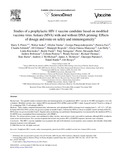Studies of a prophylactic HIV-1 vaccine candidate based on modified vaccinia virus Ankara (MVA) with and without DNA priming: Effects of dosage and route on safety and immunogenicity
Date
2007Author
Peters, Barry S.
Jaoko, Walter
Vardas, Eftyhia
Panayotakopoulos, George
Fast, Patricia
Schmidt, Claudia
Gilmour, Jill
Bogoshi, Mampedi
Omosa-Manyonyi, Gloria
Dally, Len
Klavinskis, Linda
Farah, Bashir
Tarragona, Tony
Bart, Pierre-Alexandre
Robinson, Andrew
Pieterse, Colleen
Stevens, Wendy
Thomas, Richard
Barin, Burc
McMichael, Andrew J.
McIntyre, James A.
Pantaleo, Giuseppe
Hanke, Tom´aˇs
Bwayo, JJ
Type
ArticleLanguage
enMetadata
Show full item recordAbstract
Background: Two parallel studies evaluated safety and immunogenicity of a prophylactic HIV-1 vaccine in 192 HIV-seronegative, low-risk
volunteers. Modified vaccinia virus Ankara (MVA) and plasmid DNA (pTHr) expressed HIV-1 clade A gag p24 and p17 fused to a string of
25 overlapping CD8+ T cell epitopes (HIVA).
Methods: These studies compared intramuscular, subcutaneous, and intradermal MVA at dosage levels ranging from 5×106–2.5×108 pfu.
In Study IAVI-010, DNA vaccine was given as a prime at months 0 and 1, followed by MVA as a boost at months 5 and 8. In Study IAVI-011,
MVA alone was given at months 0 and 2. Regular safety monitoring was performed. Immunogenicity was measured by the interferon (IFN)-
ELISPOT assay on peripheral blood mononuclear cells (PBMC).
Results: No serious adverse events were attributed to either vaccine; most adverse events were mild or moderate, although MVA resulted in
some severe local reactions. Five vaccine recipients had at least one positive IFN- ELISPOT response, but none were sustained.
Conclusion: This HIV-1 vaccine candidate was in general safe and well-tolerated. Local reactions were common, but tolerable. Detectable
immune responses were infrequent
Citation
ElsevierSubject
Prophylactic HIV-1 vaccine;safety;
Immunogenicity;
prime-boost;
MVA (modified vaccinia virus Ankara);
DNA vaccine
Collections
- Faculty of Health Sciences (FHS) [10378]

